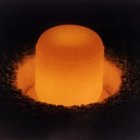This map layer presents in ten categories how many millions of people live within 30 and 150 km of nuclear power plants. The centre of the circles corresponds to the location of a nuclear power plant.
Nuclear power plants are a security risk for those who live in their vicinity. Human error, technical defects or natural catastrophes can cause reactor accidents. Nuclear power plants are also potential targets for terror attacks. Furthermore, it is also possible that nuclear material is stolen from the installations with the aim to use it against states and their population, for instance in the form of 'dirty bombs'.
The graph shows how many people could theoretically be affected by an assumed reactor accident or terrorist attack on a nuclear power plant in a certain radius and how many would have to be evacuated. The larger radius of 150 km used corresponds more or less to the evacuation radius of 170 km advised by the International Physicians for the Prevention of Nuclear War (IPPNW). Furthermore, the radius of 30 km shown around each nuclear power station corresponds to the area from which the Japanese government evacuated the population as a result of the reactor accidents in Fukushima in 2011. The calculations, however, do not take the influences of weather and wind direction on the spread of radiation into account that determine largely the real number of people affected. The population numbers, therefore, can only be taken as indications.






